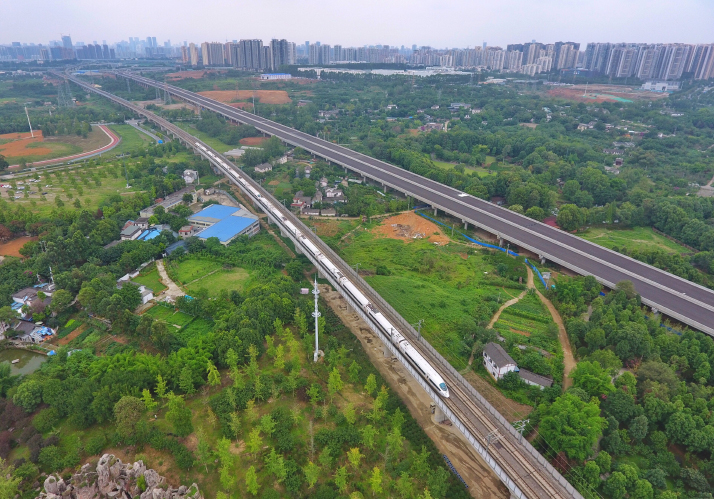| Business |
| Chengdu-Chongqing economic circle gets underway to accelerate development of western region | |
|
|
 A Chengdu-Chongqing High-Speed Railway train on July 22 (XINHUA)
The assembly line of Chengdu Huachuan Electric Parts Co. in Chengdu, Sichuan Province in southwest China, presents a busy sight with robotic arms and intelligent devices operating in tandem with human workers to assemble various sophisticated components into alternators. The five-decade-old firm, a leading manufacturer of electrical parts for the auto industry, is anticipating even better business thanks to a new national strategy announced in January, the Chengdu-Chongqing economic circle. The city cluster around Chengdu and Chongqing is a new growth driver for coordinated regional development as well as opening up west China. It is a win-win for Huachuan as the auto industry is a focus in the fast-growing economic circle. The two places will pool in their strengths to develop an auto industry cluster. According to Wan Bin, Executive Deputy General Manager of Huachuan, already over 20 percent of the company's suppliers are from Chongqing. "Chengdu and Chongqing are adjacent and have convenient transport connections, which not only improve efficiency but also save costs for us. Products delivered from our workshop will be on the assembly lines of automobile plants in Chongqing the next day," Wan told People's Daily. Chongqing is about 270 km southeast of Chengdu. Previously part of Sichuan, it became a provincial-level municipality in 1997. The Chengdu-Chongqing area has an aggregate population of 120 million and its GDP reached 7 trillion yuan ($1.04 trillion) in 2019. It serves as a junction of the Belt and Road Initiative and the Yangtze River Economic Belt, another integrated development blueprint for nine provinces, including Sichuan, and two municipalities, including Chongqing. In the north, a train route leads to Central Asia and Europe; in the south is the New International Land-Sea Trade Corridor to Southeast Asian countries. On both the east and west run transportation routes to South Asia and other Northeast Asian countries, respectively. The master plan for the Chengdu-Chongqing economic circle was reviewed at a meeting of Communist Party of China leaders in mid-October. The meeting proposed to build the Chengdu-Chongqing area into an important economic hub of nationwide influence, a center for science and technology innovation, a new spearhead for reform and opening up, and a location for a high-quality lifestyle, Xinhua News Agency reported.  The workshop of an automotive electronics company in Chongqing on March 10 (XINHUA)
New source of vitality China's eastern coastal region has led the economic boom since reform and opening up started in 1978, thanks to its three powerhouse economic circles: the Beijing-Tianjin-Hebei region in the north, the Yangtze River Economic Belt that consist of several central and eastern provinces and Shanghai, and the Guangdong-Hong Kong-Macao Greater Bay Area in the south. According to official statistics, the three circles contribute 38 percent to the country's total GDP and house 18 percent of the population though they account for only 2.8 percent of the total land area. In contrast, the western region, covering 71 percent of the territory, accounts for just 20 percent of the national economy. Therefore it needs a powerful engine to pull it forward. Yao Shujie, Deputy Director of the Faculty of Social Sciences of Chongqing University, told Outlook Weekly that the Chengdu-Chongqing economic circle is intended to be the fourth growth pole of China. The strategy will address the problem of unbalanced and inadequate regional development and drive high-quality development in the entire country. Chengdu, capital of Sichuan, and Chongqing already have a sound economic foundation. In 2019, they accounted for 33.25 percent of the total GDP of the western region. In the first three quarters this year, they achieved GDP growth of 2.6 percent and 2.4 percent, respectively, despite the impacts of the novel coronavirus disease, ranking among the top in the country, according to the Outlook Weekly report. "Though the coronavirus does not result in an end of interconnection among different countries, a trend of countries increasingly relying on their domestic markets has already started," Tang Jiqiang, founder and chief researcher of SWUFE Institution, a think tank, told Economic Information Daily. "While the Yangtze River Delta is considered the center of China's economic and trade cooperation with foreign countries, the Chengdu-Chongqing area is sure to play an important role in fostering the inherent growth momentum within the Chinese territory," Yao said. A leading force for the development of the western region, a junction between the east and the west, and linking the north and the south, the Chengdu-Chongqing area can receive industrial transfers from the coastal provinces, thus stimulating domestic demand in the region, he added. "Building the Chengdu-Chongqing economic circle into an important growth pole and a new source of vitality will help address challenges and uncertainties in and outside China and consolidate national strategic security," Tang said. Competition to coordination Chengdu and Chongqing have similar development levels and industries. With the Chengdu-Chongqing economic circle, the two cities' pillar industries will move from competition to coordination. "The overlapping of the two cities' industries is also the foundation for them to cooperate and achieve integration," Zheng Bei, head of the Sichuan Provincial Development and Reform Commission, told People's Daily. For instance, earlier this year Chongqing and Sichuan signed a memorandum of understanding on port and logistics cooperation and a one-stop service cooperation agreement on international trade. Their transport authorities have also signed an agreement on integrated development of transport services. Zheng said the cooperation between Chengdu and Chongqing will be intensified to establish industrial and value chains of global influence. In the future, they will strengthen infrastructure connectivity, industrial coordination and sharing of public services. He also said the two cities will improve the quality and level of urbanization and continue to upgrade urban infrastructure and public services. More attention will be paid to raising the primary-level capacity of governance, and making the region better able to support the concentration of industries and population. Rural-to-urban migration will be facilitated to advance economic restructuring and improve people's wellbeing. (Print Edition Title: The Fourth Growth Pole) Copyedited by Sudeshna Sarkar Comments to wangjun@bjreview.com |
|
||||||||||||||||||||||||||||||
|
